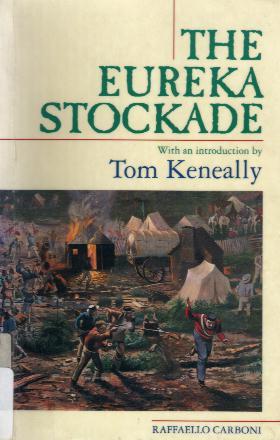
Raffaello Carboni
Introduction by Tom Keneally
1979

|
The Eureka Stockade Raffaello Carboni Introduction by Tom Keneally 1979 |
Dustjacket synopsis:
"In Australia's folk memory, one event will forever stand as the great example of courage and resistance to authority:
the Eureka Stockade.
"On the Ballarat goldfields, at dawn on 3 December 1854, 120 angry miners fought 276 police and soldiers in 'our own little rebellion'. The miners had risen in revolt against what they felt was a harsh and oppressive government. When the firing died down, five of the troops and thirty mines lay dead among the ruins of the Stockade, and a legend was about to be born.
"Here is the only full-length eye-witness account of the Eureka Stockade, published a year after the uprising, written by an Italian revolutionary who wrote the book to 'set the record straight'.
"This edition is introduced by Tom Keneally - writer, republican and upholder of human rights. To him, the events were 'a practical assertion of fair-goism which, at the cost of some anguish and death, produced good results' for the Australian people."
Quotes:
"...merits being 'prescribed' reading in every Australian school, and self-prescribed reading for every Australian
citizen" - Brian Fitzpatrick
First Paragraph from the Introduction:
This new edition of Raffaello Carboni's eyewitness account of the leadup to the Eureka Stockade and its aftermath is being issued at a time of great significance for Australia. Eureka was always a supreme event for republicans and nationalists in the Henry Lawson tradition. It is interesting to know how one eloquent participant saw the issues, the personalities and the ideas and mythology behind Eureka.
Raffaello certainly lets us know that there were Chartists and republicans on the goldfield. Through his eyes we see the Independent California Rangers, convinced of the coming benefits of an Australian Republic, march into the Stockade. He has heard the Charter adopted at meetings on the goldfields; but he is in fact ironic about all that ideology: 'Worn-out twaddle imported from old England'. When a French miner tells him, Nous allons bientôt avoir la République Australienne, Signor Raffaello replies, Quelle farce! He goes only so far as to describe himself as 'a member of the Republic of Letters'.
To Raffaello and probably to the bulk of Australians Eureka stood for something less ideologically defined - a practical assertion of fair-goism which, at the cost of some anguish and death, produced good results, including police reform, the unlocking of land, miners' courts, and universal male franchise.
First Paragraph:
I undertake to do what an honest man should do, let it thunnder or rain. He who buys this book to lull himself to sleep had better spend his money in grog. He who reads this book to smoke a pipe over it, let him provide himself with plenty of tobacco-he will have to blow hard. A lover of truth - that's the man I want - and he will have in this book the truth, and nothing but the truth.
Facts, from the 'stubborn-things' store, are here retailed and related - contradiction is challenged from friend or foe. The observation on, and induction from the facts, are here stamped with sincerity: I ask for no other credit. I may be mistaken: I will not acknowledge the mistake unless the contrary be proved.
When two boys are see-sawing on a plank, balanced on its centre, whilst the world around them is 'up' with the one it is 'down' with the other. The centre, however, is stationary. I was in the centre. I was an actor, and therefore an eye-witness. The events I relate, I did see then pass before me. The persons I speak of, I know them face to face. The words I quote, I did hear them with my own ears. Others may know more or less than I; I mean to tell all that I know and nothing more.
From the Melbourne University Press paperback edition, 1993.
This page and its contents are copyright © 2001 by Perry Middlemiss, Melbourne, Victoria, Australia.
Last modified: November 23, 2001.